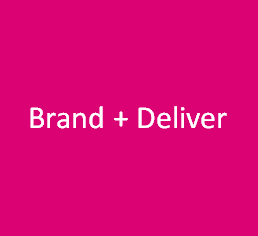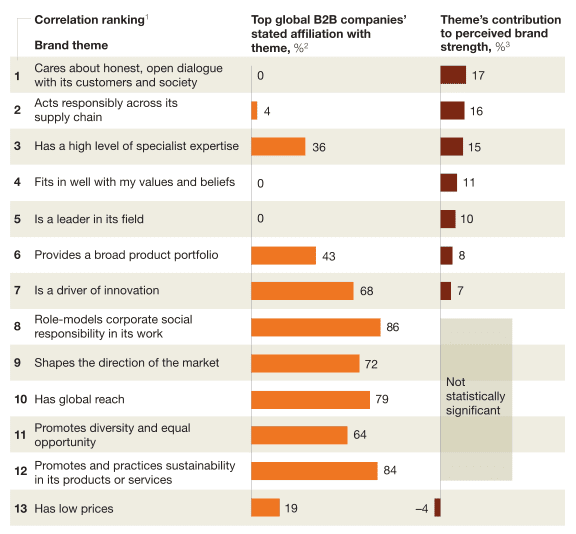6 Perennial Factors of Brand Disconnect. Deliver What Matters.
 The great disconnect between the brand messages that B2B companies say to their customers and what their customers really want to know is now a fact, according to a new research from McKinsey and Coy.
The great disconnect between the brand messages that B2B companies say to their customers and what their customers really want to know is now a fact, according to a new research from McKinsey and Coy.
According to McKinsey research, out of thirteen themes that companies use to position their brands, six are totally irrelevant to business customers. Conversely, the four topics, that bear critical importance to their customers, are completely missed by B2B companies. Take a peek at the table below to see the numbers (courtesy of McKinsey & Coy).
Four Things that Matter
The research identifies these four themes as the only ones that significantly contribute to the perceived brand strength of the supplier:
- Honest, open dialogue with customers and society – and that should include your employees;
- Responsible behaviour at all levels of the supply chain – adopting a collaborative win-win-win approach;
- Shared values and beliefs with those of the customers – at the core, it should include shared conviction to the end Brand and end customer; and,
- Being a leader in your field – leading through knowledge of the market needs and exploring trends that support and evolve this knowledge, to ensure ongoing relevance.
Not surprisingly, low price seems to be a deterrent in the B2B world. One may argue that it’s easy to lose a deal on price. There are two strategic and psychological aspects of this issue. One, low price either forces the B2B-company to take some elements out of the offer, or poses a question, ‘why is it so cheap?’
Having said that, pricing your products or services ‘strategically’ higher is not an answer when it is done without a consideration of the competitive value. Price is never about price. It is always about Value and ROI – real or perceived. A justified and ‘irresistible’ price that will result in consistent and profitable sales is a direct result of the above FOUR branding criteria.
New Ideas Not Found Inside
Let’s step outside theB2B sector for a moment: online retail. ASOS is an online retailer who flies a jumbo-jet full of cheap clothing to Australia every week. Why such demand?
Is it cheaper than our brick and mortar retailers? In the comparable market segment, probably yes. Cost leadership of the business model – lower cost of distribution and speed to market – ensures this. But don’t women like to go shopping for clothes and try them on before buying? Usually. And, what about the instant self-gratification, vs waiting a few days for the delivery? The growing popularity of this model indicates that it clearly doesn’t matter. New clothes are not a ‘necessity’ in our society, and those usually young and impatient buyers, are happy to wait for their ‘surprise’ parcel to arrive on the doorstep.
So what is the Brand value of these burgeoning online conglomerates? Understanding their customers and building strong branding around a business model that taps into the latest consumer and technology trends.
How does this example relate to a B2B proposition?
Two Things To Take Away
Good Retailers are better than B2B companies at understanding and delivering to customer’s needs – or they will quickly find themselves out of business; and they understand the power of Brand Marketing.
B2B companies, and in particular 2nd and nth tier suppliers, allow themselves to be removed from the end customer – losing their own identity and not being able to meaningfully contribute to the value of their en-Brand. This results in commoditisation of their business and limits their potential for controlling their sales and profit levels.
I often quote Intel as one of the most successful examples of branding in early stages of the B2B supply chain. Along with millions of computer buyers and users I don’t know much about microchips. Yet, the ‘Intel inside’ consistent Brand message reinforces all of the four above criteria and determines my choice of a computer.
Staying close to the end customer’s needs and building a powerful Brand message through an ‘open, honest dialogue’ that is consistent with the brand’s conviction, and positioning the Brand as a market leader, is both a necessity and an opportunity.
One More Thing
This may come as a shock to learn that a broad product portfolio in B2B market doesn’t matter. The customer only needs one solution at a time. Having said that, that once you have sold one solution, having a broad range is a great opportunity to stay in touch, up-sell and sell more often.
 InnoFuture provides innovative business culture transformation services to progressive, Small-Medium organisations. Sign up for our In-Crowd list to connect to the local and global innovation though leadership. Or, attend our EVENTS: InnoFuture RIOT is a program of Rapid Insight Online Talks where we share insights on Business Culture | Branding | Innovation.
InnoFuture provides innovative business culture transformation services to progressive, Small-Medium organisations. Sign up for our In-Crowd list to connect to the local and global innovation though leadership. Or, attend our EVENTS: InnoFuture RIOT is a program of Rapid Insight Online Talks where we share insights on Business Culture | Branding | Innovation.
For for urgent help contact us and take the 1st step to making your organization be more focused, more differentiating and more competitive.
FOLLOW US
QUICK LINKS

